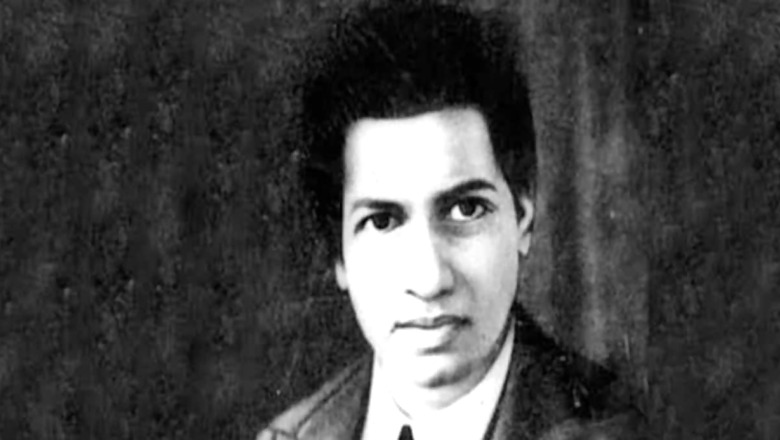
views
On December 22, 1887, Srinivasa Ramanujan was born to Kuppuswamy Srinivasa Iyengar and Komalathammal. Kuppuswamy worked at a saree shop in Kumbakonam, Tamil Nadu, while Komalathammal took care of the household work. Ramanujan had three younger siblings but none of them survived beyond infancy. His father spent much of his time at work, so Ramanujan spent a lot of time with his mother and learned all their family traditions from her. Poverty and family circumstances forced Ramanujan and his mother to move from Kumbakonam to Kanchipuram and back to obtain family support and, eventually, to Madras (as Chennai was known at that time) during his childhood.
His obsession and talent for mathematics was evident from childhood, as he would regularly complete exams in half of the time allowed and exhaust the mathematical knowledge of everyone he talked to. In his teens, he was lent books whose dense information he absorbed quickly, before building on the work they contained by scrawling on his slate. He had a few notebooks, which he used sparingly, only to write the results he obtained as opposed to including the steps he took to get there.
The first book he really grappled with was ‘Synopsis of Elementary Results in Pure Mathematics’. It compiled thousands of theorems without proof and was intended as a summary of the undergraduate-level math that was developed at the time for students to revise. This book probably influenced him the most, as he became an experimental mathematician — playing around with numbers, seeing what comes up, and trying to make sense of the results afterwards. This contrasts with most mathematics then (and indeed today), wherein one starts from a set of axioms and makes logical deductions until a theorem is proven. While this experimental approach had been used by others before (Newton would have long pages of calculations in his notebooks), they took care to differentiate between statements they logically proved (theorems) and statements they believed but weren’t proved (conjectures), whereas Ramanujan did not. He saw himself as a scientist in a lab, making empirical observations. Upon graduating school, he got a scholarship to go to college, but focused too much on math and too little on other subjects, leading to him failing in all subjects except math and, thereby, his expulsion.
After leaving college in 1906, he struggled to find a job, often living in extreme poverty. Due to his intense passion, he continued his research. His first real recognition was a chance encounter in 1910 with the founder of the Indian Mathematical Society (IMS), V. Ramaswamy Aiyer, who saw his work, was stunned, and introduced him to his mathematician friends in Madras. With the help of others in the society, particularly financial support from R. Ramachandra Rao, who was the Secretary of IMS, he continued his work and started contributing to the society’s journal.
He eventually got a job in March 1912, as an accounting clerk (essentially a human calculator) for the Madras Port Trust. Since he didn’t have any degree in accounting (or in anything for that matter), he had to use his connections from earlier, one of them being that of Edgar William Middlemast, a Mathematics professor at the Presidency College, whose recommendation stated that Ramanujan was “a young man of a quite exceptional capacity in Mathematics.” Ramanujan, predictably, did his job very quickly and in his spare time, he continued his research, still in relative obscurity.
In 1909, Ramanujan married 10-year-old Janaki, a girl from Rajendram village near Marudur in Coimbatore district. After marriage, Janaki continued to live at her parents’ home and came to live with Ramanujan in his home at Triplicane when she came of age in 1912. In the spring of 1913, Ramanujan wrote to British mathematicians about his work, with aid from the other mathematicians in India who had supported him with the job. Many were drawn away due to Ramanujan’s mathematics being too novel and unfamiliar, combined with his terse “just the facts” presentation.
Eventually, he wrote to G.H. Hardy at Cambridge University. While Hardy was sceptical, like the others, he took a rather different approach. He concluded that the results “must be true, because, if they were not true, no one would have the imagination to invent them.” He discussed the letter with his close friend Littlewood, whose research interests were more similar to Ramanujan’s and he echoed similar sentiments. Hardy wrote back, explaining his interest in Ramanujan’s work. He lumped the results into three categories: already discovered, new and interesting but probably not important, and new and important. For Hardy, and indeed for all mathematicians, logically airtight proofs of results were important — not just for confidence, but to shine a light on why the result is true and how well it can be generalised. Thus, he asked Ramanujan for proof of the assertions. When Ramanujan replied, he attempted to give some fragments of reasoning for his results — but because his methods differed so starkly from everyone else’s, it was a struggle. He made a point to state that of the three categories Hardy mentioned, the “already discovered” one was the most heartening to him — as it reassured him that those results were indeed correct. Hardy and Littlewood pored over what little arguments Ramanujan gave, and while some of them were flat-out wrong, they were, for the most part, impressed with what they saw. Impressed enough that they invited Ramanujan to come to Cambridge and work with them. Ramanujan refused since leaving India was considered taboo for a Brahmin at the time.
In the meantime, news of Hardy’s response prompted the University of Madras to give Ramanujan — a mathematician with no formal training — a research scholarship, and he regularly published results in Indian journals. Eventually, Ramanujan relented and on March 17, 1914, he boarded the S.S. Nevasa and arrived in London on April 14 where he was received and taken to Cambridge where his most productive period began. He spent nearly five years working with Hardy and Littlewood.
Ramanujan was awarded a Bachelor of Arts by Research (the predecessor of the PhD degree) in 1916 for his work on highly composite numbers. In 1917, Ramanujan was elected to the London Mathematical Society and in 1918, he was elected a Fellow of the Royal Society (the second Indian admitted after Ardaseer Cursetjee in 1841) and one of the youngest fellows in the Royal Society’s history. Again in 1918, he became a Fellow of Trinity College, Cambridge, being the first Indian to be elected.
Ramanujan’s impoverished life in colonial India had resulted in an extremely weak immune system and he was prone to frequent illnesses. The extremely cold weather at Cambridge and the difficulty to meet his requirements for strict vegetarian food did not go well with him. In 1917, as the First World War raged, he fell extremely sick and had to be hospitalised several times. Due to the war, he was not able to return home and his wife, too, was unable to come to England to take care of him.
During that time, Hardy came to see him and remarked to Ramanujan that the number on the cab that he had ridden — 1729 — seemed rather a dull one. “No,” replied Ramanujan, “it is a very interesting number; it is the smallest number expressible as the sum of two cubes in two different ways.” Just prior to this, Littlewood had told Hardy, “Every positive integer is one of Ramanujan’s personal friends.”
Hardy said that from a scale of 0 to 100, if mathematicians were to be gauged, he would give himself 25, Littlewood 30, Hilbert an 80, and Ramanujan a 100. Littlewood remarked that Ramanujan was of a different species. Ramanujan’s connection to numbers was intuitive, perhaps even subconscious. He looked to Namagiri Thayar, his family deity, for inspiration in his work. He said that he had visions of complex mathematical content unfolding before his eyes. He said, “An equation for me has no meaning unless it expresses a thought of God.”
Finally, the war ended and in 1919, he returned home to a more suitable climate and the comfort of being with his family and home-cooked food. However, his health did not improve despite the best efforts of Janaki, who cared for him relentlessly. He passed away on April 26, 1920. He was just 32 years of age. Later, from the description of his symptoms, it was observed by medical experts that he suffered from a curable infection which had been misdiagnosed as Tuberculosis. The year after his death, Nature listed Ramanujan among other distinguished scientists and mathematicians on a ‘Calendar of Scientific Pioneers’ who had achieved eminence.
Tamil Nadu celebrates December 22 as ‘State IT Day’. Ramanujan IT City is an information technology special economic zone in Chennai that was built in 2011. Stamps commemorating Ramanujan were issued by the Government of India in 1962, 2011, 2012 and 2016. Since Ramanujan’s centennial year, December 22 has been annually celebrated as Ramanujan Day by the Government Arts College, Kumbakonam, where he studied, and at IIT Madras. In 2011, on the 125th anniversary of his birth, the Indian government declared December 22 to be celebrated as National Mathematics Day and that 2012 would be celebrated as National Mathematics Year. The International Centre for Theoretical Physics has created a prize in Ramanujan’s name for young mathematicians from developing countries in cooperation with the International Mathematical Union, which nominates members of the prize committee.
SASTRA University has instituted the SASTRA Ramanujan Prize of $10,000 to be given annually to a mathematician, not exceeding age 32, for outstanding contributions in an area of mathematics influenced by Ramanujan. Based on the recommendations of a committee appointed by the University Grants Commission, the Srinivasa Ramanujan Centre has been declared an off-campus centre under the ambit of SASTRA University. House of Ramanujan Mathematics, a museum of Ramanujan’s life and work, is also on this campus. The University purchased and renovated the house where Ramanujan lived in Kumbakonam.
The impact of Ramanujan’s work continues with mathematicians poring over his formulae and working to solve them. His discoveries have found applications in many spheres of science and continue to find new uses. “No one was talking about black holes back in the 1920s when Ramanujan first came up with mock modular forms, and yet, his work may unlock secrets about them,” says Ken Ono, Mathematician at Emory University. His discovery, the K3 surfaces, has been the foundation of the String Theory. At IIT Madras in 2011, Bruce Berndt said, “Over the last 40 years, as nearly all of Ramanujan’s conjectures have been proven, there has been a greater appreciation of his work and brilliance, and his work is now pervading many areas of modern mathematics and physics.”
Ishwar Karthik studies Mathematics at Oxford University in the UK. He was among the first 4 recipients – and the youngest – to receive the Spirit of Ramanujan Prize at Emory University in Atlanta, Georgia in 2017, at the age of 13; Yamuna Harshavardhana is a karyakarta at Bharatiya Shikshan Mandal. She authored the book, ‘Vidya: Re-rooting the Beautiful Tree’ which was published in 2022. Views expressed are personal.
Read all the Latest Opinions here



















Comments
0 comment